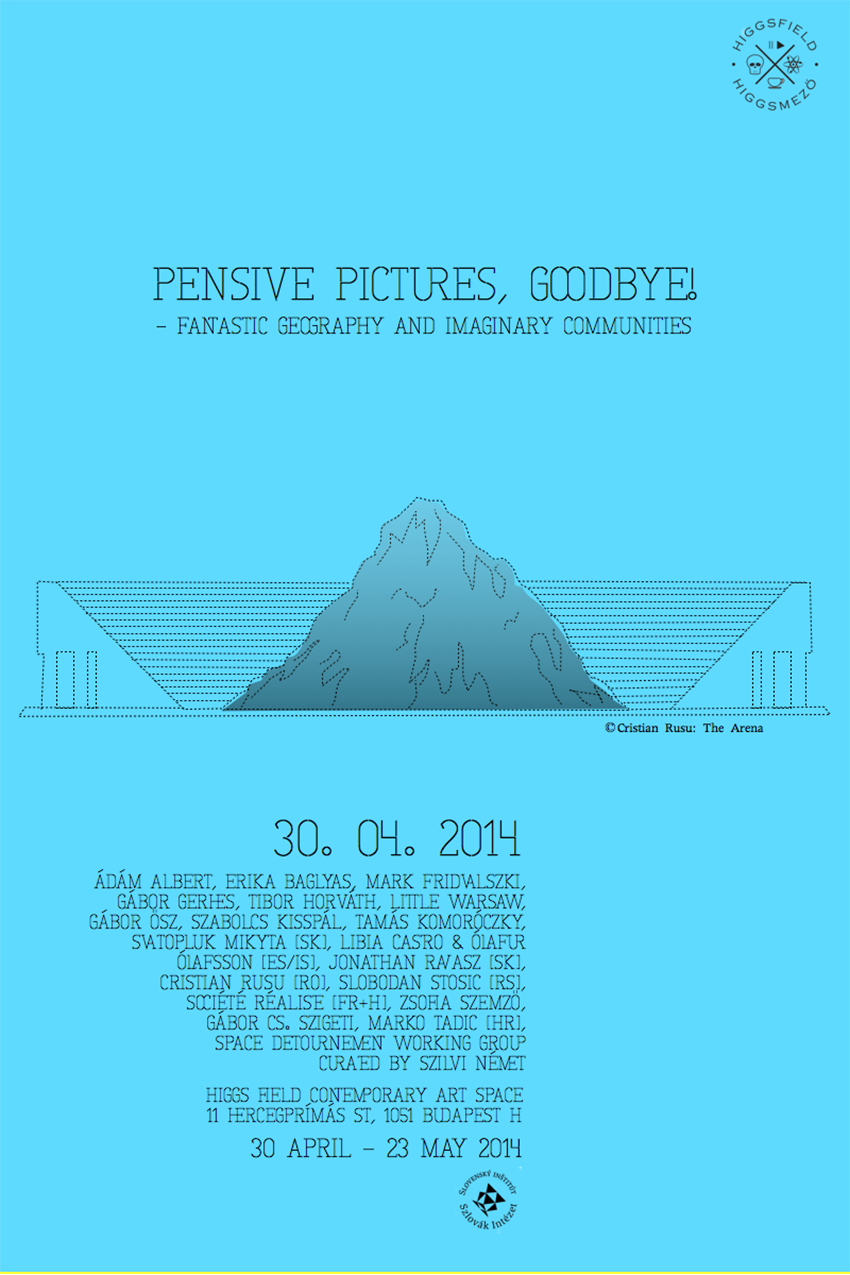https://artycok.tv/en/25672/pensive-pictures-goodbye-fantastic-geography-imaginary-communities
Ádám Albert, Erika Baglyas, Mark Fridvalszki, Gábor Gerhes, Tibor Horváth, Little Warsaw, Szabolcs KissPál, Tamás Komoróczky, Svatopluk Mikyta (SK), Libia Castro & Ólafur Ólafsson (ES/IS) , Gábor Ősz, Jonathán Ravasz (SK), Cristian Rusu (RO), Slobodan Stosic (RS), Société Réaliste (F+HU), Zsófia Szemző, Gábor Csongor Szigeti, Marko Tadic (HR), Space Detournement Working Group
curated by: Szilvi Német
official opening: 30th April 2014, 7 pm
on view: 30th April - 23 May 2014
https://vimeo.com/98124995
Higgs Field Contemporary Art Space
11 Hercegprímás street, 1051 Budapest Hungary
opening hours:
www.higgs.hu
partner: Slovakian Institute, Budapest
https://www.artmagazin.hu/articles/video/4c5e74580417f699834e216be2658063
The group show thematizes what we would call geopolitical fantasies sprang into existence by artistic projects primarily from the CEE region, bringing under close scrutiny the historical relation of natural space and communities (society). The clandestine or explicitly expressive moral, ideological and political agenda of the territorial references settled on the view or terrain by power structures is problematized by the works exhibited. Thus revealing "the black side of the landscape", the "hard facts" behind the once aesthetically or ideally concieved image of the living space.
The landscape under the abstracted agit propaganda of identity politics is constituted as a medium rather than an artistic genre, better as a communicational platform for nationstrategy than just a plain view for resting the eye on. It serves a telling ground for showing ideology in practice, with modelling the working process how ideology shows up a masterpiece of social construction as if being inalterable, eternal and innocent as Nature itself. Onthologically speaking, with the introduction of the political in the very bourgeois concept of landscape design, the contemplative nature is bedimmed by the interpretative body of codes of a new geography. The inconsequent, but many time very deliberate, neopopulist interplay between the concept of nature and landscape is just one example for the malignant policy of landscapes today. Under the threat of cultural homogenization the idea of the nationstate revives together with its territorial claims and the notion of national or ethnic land endures even though its introverted tactics fails to meet contemporary social reality. Geological elements thus became part of a false historical pastiche existing in occult or esoteric political mythologies, as described very illuminatingly by Buckminster Fuller as part of a local focus hocus pocus of the big picture.While today an increasing privatism, localism and cultural tribalism is to be found, they co-exist with transnationalism or internationalism that make a mockery of frontiers. The exhibition aims at analysing the connection between the bondings that play part in the formation of these 'imaginary communities' and their attachment to territorial locations. The field of research thus stretches the disciplines of human ecology an anthropological geography, but is also informed by the latest findings and visual representations of identity politics, socio-psychology or communal memory. The outcome is to make up a visual anthology that reveals the constructed nature of political mythologies and pictorial symbolism extracted from the geopolitically applied genus loci. Finally there should stand a citation from Hakim Bey, notorious author and mastermind of the TAZ-theory (Temporary Autonomous Zone) that says 'Lay down a map of the land; over that, set a map of political change; over that, a map of the Net, especially the counter-Net with its emphasis on clandestine information-flow and logistics--and finally, over all, the 1:1 map of the creative imagination, aesthetics, values.'
